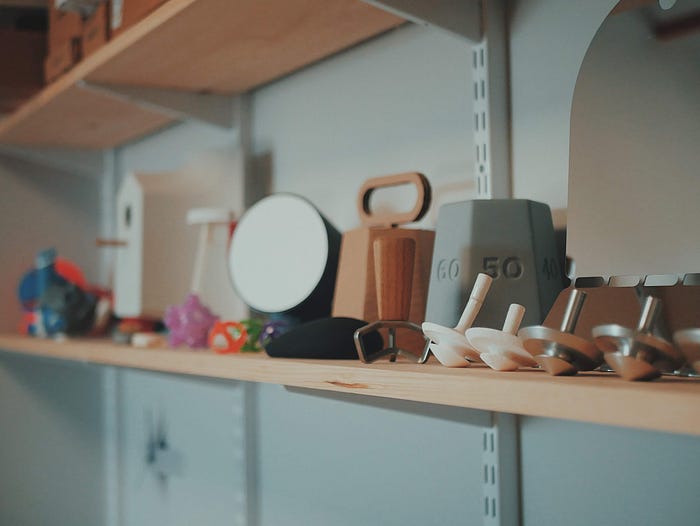Interview with Nicholas Baker, Industrial Designer & Virtual Reality Sketcher
Nicholas Baker is an industrial designer based out of Brooklyn. He studied at SCAD and has worked for Petmate designing toys for cats and dogs. His work has been featured in Yanko Design, Core77, Fast Company, and more.
Nicholas currently lives in Bed-Stuy with 3 roommates and a lot of plants. He has a small studio a few blocks away and consults with a range of clients, designing anything from wearables, to medical products, to pet toys, to housewares.
You can find Nicholas on Instagram, LinkedIn, Behance. He also co-hosts an industrial design podcast with his friend James Connors called Minor Details. You can find more on his website, nicholas-baker.com.
If you have any questions about this project or are interested in being interviewed, feel free to DM me on Instagram or reach out on LinkedIn!

How did you get into design?
I’ve always been into art and making things. I was always drawing as a kid and building with LEGOs. My grandfather was an architect and he would always build things with me in his woodshop. We would sketch out planes and cars and build them out of wood. I actually didn’t even know what industrial design was until I start applying to colleges. It popped up as one of the majors and after I read the description a lightbulb went off. I knew that industrial design was exactly what I wanted to do.
Do you have a design philosophy?
I’m not sure if I practice it for every project but I’ve been working on this idea I call Familiarism. It’s the idea of taking a familiar interaction and combining it with an incongruous object. For example, I created a bottle opener that spins; the spinning top is a familiar interaction and that interaction is not usually found on bottle openers. This creates a unique and delightful object. Familiarism is something I’m still forming and you can read more at nicholas-baker.com/familiarism.
Another part of my design philosophy is to create things that make you smile or give you a bit of a surprise. I think a lot of designers try to solve the world’s biggest problems, but I’ve always found that it’s the little things that change the world; like a fun little interaction in your morning routine that makes your day a little bit better. These small things can have a snowball effect and can improve the quality of life.

What are some resume mistakes you see?
The most common mistake I see is listing out all the programs you use (like Photoshop) and adding an arbitrary number of stars to it. Another mistake common in industrial design resumes is that they are visually messy and have too many graphics. I recommend using smaller type size like 8 or 9pt — it looks more sophisticated.
Why is having a presence on Instagram important to you?
I started posting on Instagram with no intention of gaining followers. For me, it’s been a place to experiment with my ideas. I started it as an exercise like going to the gym — I was working at Petmate and wanted to motivate myself to keep honing my skills. I would post something every day — sometimes posts of me camping, or a sketch, or something I made out of wood. I posted every day for a year. I really just like creating things and experimenting with new techniques and crazy concepts. And, I’m grateful that people have decided to come along for that journey. The benefits have been exponential — not only has my skills improved exponentially over time, I’ve been connected to client work, made awesome friendships, and gained the confidence to quit my job, and start my studio in New York.
What is your advice to designers looking to grow their instagram accounts?
I think the idea of growing an IG account is the wrong way to look at it. The main thing is to post because you love it. Post whatever you are excited about and people will gravitate toward that good energy. Growing an IG account is simply a side effect of posting great work consistently. Don’t fall into the trap of posting whatever others are doing. Keep experimenting with new mediums or styles and see what you enjoy the most. You can get burnt out if you are doing the same thing over and over, so always be mixing it up.
Have you ever messed up a design?
I definitely messed up at Petmate. I made some manufacturing mistakes with cat toys and didn’t understand the concept of uniform wall thickness in plastic parts. The cat toy warped and the ball kept falling out of the track. We got a lot of bad reviews, but eventually went back and fixed the design.

How do you see differences and similarities in UX design and industrial design?
I think the common perception of UX is app design, but user experience can expand beyond apps to anything that someone interacts with, digital or physical. There’s definitely a commonality in the problem solving and research side of UX and ID. What I see in industrial design that I don’t see as much in digital is the use of intuition. Occasionally, I’ll create things because I think it would be cool or fun; whereas in UX, I feel like it’s often very focused on what the research says. I think that all designers can sometimes get stuck on the research and forget about adding a bit of that human touch. Steve Jobs didn’t cater to what people wanted; the research showed that everyone wanted a physical keyboard or a stylus. Instead he followed his intuition and thought: how about no keyboard? I think true innovation comes from dreaming up the future, and research is inherently based on the past. I think the reason I see this in industrial designers more than UX designers, is it’s much harder to A/B test a physical product as compared to an app.

What drives you to create?
I don’t know. Some deep underlying passion for it? It might just be how I was born: my drive to create is always on and I can’t switch that off.
What design skills do you think are useful, but not taught in school?
Presentation is a big one. You can have the best idea in the world, but if you present it poorly, no one will take notice. Or I’ve seen some terrible ideas presented very well, and they often get a lot of praise.
What do you think makes a great designer?
I think a great designer is someone who can see the problem and empathize with the user, but also has the ability to bring a bit of intuition and aesthetic sensibility into the design. It’s a balance, I think you need both research and intuition. A lot of times, people lack one or the other. Another thing is to practice restraint in regards to aesthetics and functionality. I’ve seen inexperienced designers add too much functionality thinking that multi-function adds value. Or, I’ve seen designers take too much aesthetic inspiration and the design lacks any visual hierarchy. Being able to distill something down to the essence is a good skill to have. I think we all agree that’s the goal, but it’s much harder to put into practice.
What do you think makes a bad designer?
I think a bad designer only thinks on a surface level. They might see some new trend or aesthetic and try to recreate it — but lack the deeper understanding of why.

What challenges do you face when collaborating with others?
Making things is hard. As an industrial designer I’m often collaborating with mechanical engineers. Designers often have grandiose dreams about their design so there’s always a good bit of compromising to meet the engineering needs.
What are some of the challenges you’ve faced in your professional career?
The hardest thing has been being the transition to working as an independent designer. When you work for a company, you wake up, go to the office, and come home at 5. Building your own thing is much harder. There’s no one telling you what to do or how to do it. There’s no delineation between work and life anymore. I’m a designer by heart and love making design decisions but not business decisions. I drag my feet on making invoices, writing emails, scheduling calls, responding to messages, etc. I’m also a terrible planner, and I’m a much better doer.
What are the most common mistakes you see in design portfolios (UX or industrial)?
The worst thing is when someone does not arrange their portfolio for the medium they’re posting on. When someone uploads their pdf portfolio to behance or a website it’s frustrating to me. No one ever uploads a pdf to instagram, so why would someone upload a pdf to behance. The best thing to do is to take the images and text out of the pdf and format them appropriately for each medium.
What’s your biggest design pet peeve?
My biggest pet peeve is when someone doesn’t make their sketch pages white and it has very little contrast. It only takes a second in photoshop to make your sketches pop.

What are your thoughts on virtual reality?
In general, with any new technology there’s always benefits and drawbacks. You can debate all day whether VR is good or not, but I think that VR is here to stay. In regards to design, I think VR sketching is really going to change the game. There’s something that happens when you are in the virtual world that changes how you think. Being in VR eliminates a lot of distractions and lets you focus. Since VR sketching is in a 3D space you don’t have to worry about perspective or shading like traditional sketching. This can speed up the design iteration phase significantly. I can do ten concepts in 20 minutes instead of 2 hours.
